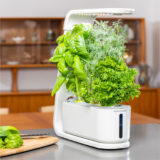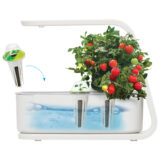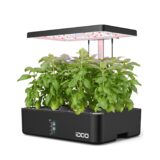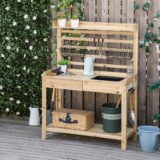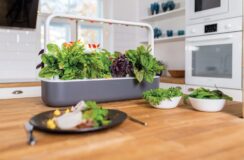
Smart gardening is the perfect way to save money on your grocery bill. It’s fun, requires little effort, and it can be done indoors year-round. Plus, you get to cook with fresh herbs and vegetables. The best part of smart gardening is that you don’t need to have a green thumb. It’s a smart system that takes out all the guess work in growing your own food.
In this article I’ll cover what smart gardening is, the kinds of foods you can grow indoors, and the benefits they offer over store-bought foods. Finally, I’ll look at some broader gardening supplies to take your new found hobby outdoors and save money on your grocery bills.
Garden indoors with a smart garden
A smart garden is a system that uses apps, hydroponics and LED lighting to monitor, automate and optimize plant growing. Unlike soil, hydroponic systems are nutrient-rich water solutions. They provide all the essential minerals and nutrients plants need to grow. The roots absorb the nutrients in the solution and bring it up to the plant. The main benefit of hydroponics is growing efficiency. Compared to soil, the growing time from seed to harvest is significantly reduced.
Most smart gardens are compact kits that sit on a countertop or table. The LED lighting mimics the sun’s natural spectrum, and can be programmed to turn on and off inside an app. As the plant grows, some models have LED lights that can be adjusted and raised up. Most smart garden systems feature built-in reminders when it’s time to add water and nutrients so you know exactly when and how to care for the plant.
Seeds and nutrient accessories
Smart garden systems typically require special seed pods for various types of plants. You can order them online and have them shipped for convenience. Pods can sometimes contain seed and nutrients together. Usually you buy kits with multiple pods together or purchase them individually.
Other systems have separate liquid plant food for hydroponic reservoirs. Each system is a little different so it’s a good idea to familiarize yourself with all the accessories. The price of pods vary, but they are still cheaper than buying plants from the grocery store.
What can you grow in a smart garden
There are over 75 varieties of herbs, flowers and leafy greens that you can grow indoors. Most smart gardens offer a wide variety of greens including lettuce, chard, kale, and arugula. A popular choice for indoor growers are herbs like basil, mint, parsley and cilantro. However, some smart garden systems also allow you to grow fruits like chili peppers, peas, tomatoes, and strawberries!
If you want to add colours and fragrance to your home, you can also use a smart garden to grow live flowers indoors. There are pods available for a wide variety of flowers including lavender, white snapdragon, and gazania. Smart gardening really makes for a great hobby with a wide variety of herbs, fruits, greens and flowers to choose from.
How much can you save with a smart garden?
If you’ve been in a grocery store lately, you know that food prices have gone up. Many people are looking for affordable ways to eat healthy. Smart gardens allow you to save money on expensive food items. For example, small quantities of herbs like dill and chives are very expensive. With little effort, you can grow expensive herbs in the kitchen and use them when you are cooking.
To save money, a good tip is to stagger the growth cycle of plants you use the most. For example, if you eat a lot of lettuce, stagger new pods every 2 weeks. That way, you’ll have lettuce growing in different stages. When one is finished, another will be ready for harvest. Keep an eye out on the plants that cost the most in grocery stores. If you buy those plants often, grow those ones at home.
Fresh foods are more nutrient-dense
A common issue with grocery store produce is lack of freshness. Fruits and vegetables tend to lose 50% of their nutrients within a week of being harvested. However, they can take weeks to reach the store. With smart gardens, you get access to the freshest food possible. Plus, you have peace of mind knowing that no pesticides or harmful chemicals were used. Not only does fresh food taste better, but it’s also better for you.
Gardening supplies for outdoor growing
With an indoor smart garden, chances are you’ll get the gardening bug. If you have space outside and want to grow your own food, there are a variety of lawn & garden products available to help you achieve that. With greenhouses, you can build a contained outdoor growing space to protect plants from the wind and animals. Garden tools such as compost bins, garden work benches, and landscaping fabric can also help protect your plants against weeds so you can successfully grow and enjoy your fresh fruits and vegetables.
For outdoor gardening, a good idea is to purchase planters and flower pots. These provide a dedicated raised enclosed garden bed. Start plants inside the greenhouse early, then transplant them outside when the weather is better. If you stagger the growing cycle, you can create a perpetual vegetable garden to feed your family throughout the growing season. You can also freeze fruits and vegetables like peas, blueberries, and spinach so you can use them during the winter month.
Save money by growing your own food
By now, we all know that food prices have gone up. This makes it a great time to start growing our own food. Not only is it a great hobby, but it can also help us feed our families and save money on our grocery bills. With smart gardens, anyone can grow their own food indoor with little to no effort.
Once you get started with a smart garden, the trick is to always have new pods available. A good tip is to subscribe to a subscription plan. That way, pods for all the foods you grow and eat will automatically be delivered to you. Your smart garden will function 24/7, 365 days a year. If you do the math, this method makes sense. Once you catch the gardening bug, you can then move outdoors with greenhouses and dedicated raised garden beds.
If there was ever a time to make gardening a hobby, it’s now. Head to Best Buy to learn all about how you can grow your own food and save money with a smart garden.

